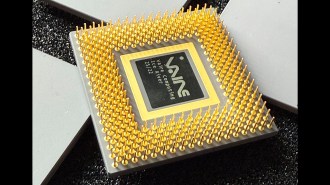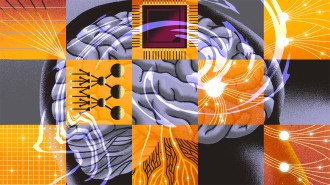- More than 2 years ago
Browsing the World Wide Web is a breeze. Just click on a link or type in a Web-page identifier–the so-called uniform resource locator, or URL. More often than not, the requested page appears on your screen within seconds, downloaded from a computer that could be anywhere in the world.


We owe such reliable, speedy service to a standard set of procedures that governs communication between computers connected to the Internet. Largely invisible to the user, these protocols orchestrate an intricate duet of messages between interacting computers to guarantee that the right page appears in the right place at the right time.
Those very same protocols, however, can be used for purposes entirely unintended by the protocols’ designers.
The communication system that brings you the Web page of your choice can be exploited to perform computations. In effect, one computer can co-opt other Internet computers to solve pieces of a complex computational problem. The enslaved computers simply handle what appear to be routine Web page requests and related messages, but the disguised messages ingeniously encode possible solutions to a mathematical problem. If the solution is correct, a message returns to the original sender.
Physicists Albert-Lszló Barabsi and Hawoong Jeong and computer scientists Jay B. Brockman and Vincent W. Freeh of the University of Notre Dame in Indiana describe their scheme in the Aug. 30 Nature. They call it parasitic computing. “The target computers are unaware that they have performed computation for the benefit of a commanding node,” the researchers remark.
It’s a brilliant demonstration of how to solve difficult problems by subverting protocol features, says computer scientist Matthias Bauer of the Friedrich Alexander University of Erlangen-Nuremburg in Germany.
The fact that the target computers are unwitting participants in a computation differentiates this scheme from other efforts to use the processing power of thousands of computers distributed throughout the world for massive data crunching. In the SETI@home project, for instance, users must install special software that enables their computers, when otherwise idle, to download and scan data from radiotelescopes for signals that might point to the existence of extraterrestrial life (SN: 3/4/00, p. 152: http://www.sciencenews.org/20000304/bob1.asp).
“If parasitic computing imitates nature by not killing the parasite’s host, it could be an interesting technology,” Bauer observes. However, like parasitism in biology, parasitic computing can have deleterious effects. It could slightly slow a co-opted computer, but on a larger scale, it might clog or even bring down the Internet.
Key component
The seemingly simple request for a Web page involves a significant amount of frenetic behind-the-scenes computation aimed at finding, delivering, and displaying the desired page. One key component, governed by the so-called transmission control protocol (TCP), involves a calculation to determine whether a chunk of data was delivered without error.
Information sent across the Internet is typically split into small chunks, or packets, that travel–often independently of each other–to their common destination. Each packet bears a header providing data about its source and destination and carrying a numerical value related to the packet’s contents.
When a computer receives a packet of information, it checks for errors by performing a calculation and comparing the result with the numerical value in the packet’s header (see “How TCP error detection works,” below). Such a calculation would detect, for example, the change of one bit from 0 to 1 or 1 to 0. Packets found to be corrupted are discarded. In that case, the interrogating computer receives nothing and eventually displays, “The server is not responding” or something similar.
To obtain “experimental evidence of the principle of parasitic computing,” Barabsi and his colleagues embedded potential solutions to a particular mathematical question (see “Getting satisfaction,” below) in Web request messages sent from their own computers. When other computers linked to the Internet received the messages and put them through the standard TCP error-detecting routine, they also incidentally relayed information about the validity of the embedded answers.
If a message incorporated a correct answer, it survived the target computer’s error check, and the target computer replied to the interrogating computer. Otherwise, the target computer dropped the message and sent nothing back to the interrogator. Hence, each reply would signal a correct solution.
In effect, by capitalizing on a calculation that Internet computers do anyway, Barabsi and his coworkers tricked each target computer into handling a small piece of a large mathematical puzzle. “We found a way to use the Internet as a computer,” Jeong says.
The Notre Dame team tested its scheme by exploiting several “consenting though unwitting” Web site hosts in North America, Europe, and Asia. Subsequent experiments were conducted over local networks.
“Parasitic computing does not compromise the security of the targeted servers,” the researchers insist. It “accesses only those parts of the servers that have been made explicitly available for Internet communication.”
Nonetheless, Jeong comments, the team’s demonstration raises many issues about the “ownership” of resources connected to the Internet. For instance, what does a computer owner actually consent to by connecting the computer to the Internet?
Does that consent include uncompensated use in parasitic-computing projects?
At the same time, “if one considers how much computing power and bandwidth are used by programs nowadays without the consent of the user, one could ask if it really makes a big difference,” Bauer says. For example, newly installed software may automatically link to a company’s Web server for license information and updates. Also, Web servers often deliver unsolicited advertising or download information to remote computers.
“It is certain that if your space is public, someone is using it without your knowledge and in a way you did not intend,” Barabsi and his colleagues contend.
Delayed services
Although parasitic computing does not threaten the security of a target computer, it could delay the services that the target computer normally provides. On a sufficiently large scale, such slowdowns could disrupt the Internet. As such, parasitic computing could even be used as a weapon in cyberwarfare.
The example chosen and implemented by Barabsi and his collaborators in their parasitic computing experiments poses no threat. Their primary goal was simply to prove the idea that the communications protocol of the Internet could be used to carry out computations. Indeed, the mathematical problem they used as a test for parasitic computing could have been solved much more practically and in less time on a desktop computer.
Finding a way to increase the efficiency of the process would make parasitic computing more attractive for working out mathematical problems. It remains to be seen whether that can be done.
Despite the inefficiency and impracticality of their approach so far, the Notre Dame team already has encountered criticism for calling attention to ways that communication could be turned into computation.
The researchers responded with the following statement: “By publishing our work we wish to bring the Internet’s various existing vulnerabilities to the attention of both the scientific community and the society at large, so that the ethical, legal, and scientific ramifications raised by it can be resolved.”
Moreover, similar schemes could be used for purposes less innocent than mathematical calculation. “There are many ways to bring down the Internet and its attached systems,” warns security expert Peter G. Neumann of SRI International in Menlo Park, Calif.
Consider what Bauer describes as “villain-to-victim” computing–schemes that take advantage of various Internet protocols for sharing or storing information. Such covert links could permit individuals to communicate via approved channels yet escape detection or filtering, a possibility now heightened by concern about terrorism.
In the continuing cat-and-mouse game between parasite and host, and villain and victim, software-based systems to detect intruders enable Web site hosts to monitor requests made to their servers. For instance, Aaron Walters, Tom Slabach, and Curt Freeland of Notre Dame have written instructions that catch the specific sort of intrusion represented by parasitic computing based on TCP error checking.
Although you can find a way to detect a specific version of parasitic computing, “I think it is impossible to protect against all . . . techniques,” Jeong says. “Whenever you’re connected to the net, there will be a part someone can exploit.”
There is a simple defense, of course. Just disconnect.
How TCP error detection works
All Web computers perform a simple calculation that lets a receiving computer check whether a particular message or packet arrived without getting corrupted along the way.
The sending computer first breaks the entire message into segments, each consisting of 16 bits. All the segments are then added together using a variant of binary arithmetic that gives a 16-bit result. Suppose the result is 1110101011011011. The sending computer flips each bit in the result so that 0s becomes 1s and 1s becomes 0s, obtaining the complementary string 0001010100100100. This complementary string is incorporated into the message header, and the message is sent.
The receiving computer breaks the incoming message into 16-bit segments, calculates the sum, then adds it to the complementary string in the header. If the message arrived unscathed, the result–called a checksum–is a string of 16 1s. If any bit in the message is altered during transmission, the checksum would be different. In that case, the receiving computer would drop the message and send nothing back to the interrogating computer. Otherwise, a message that passes the error-detection stage goes through the hyper-text transmission protocol (HTTP), which attempts to interpret the message’s content.
Getting satisfaction
To demonstrate the feasibility of parasitic computing, Barabsi and his collaborators chose a mathematical question known as the satisfiability problem (SN: 5/6/00, p. 296: http://www.sciencenews.org/20000506/bob1.asp).
Consider, for example, two variables, x and y, and the logical statement (x OR y) AND ((NOT x) OR (NOT y)). The OR means that the clause (x OR y) is true if either x or y is true, and the AND means that the clause (x AND y) is true only if both x and y are true. Solving the given problem means assigning a value of true or false to each of the two variables so that the entire statement is satisfied. Here, x must be true and y false, or vice versa, for the statement to be true.
The researchers chose a much more complex satisfiability problem that involved 16 variables and the logical operations AND and XOR. The operator XOR means that the clause (x XOR y) is true only if x is true and y is false or if x is false and y is true.
First, the interrogating computer generated all 216 possible solutions to the given satisfiability problem. In this test case, only one of those solutions was valid. The computer then created a message and a header for each possible solution so that a target computer–at, say, a company or magazine Web site–performing TCP error detection would obtain the correct result only if the message contained a valid solution. If the result was incorrect, the target computer would drop the message.
The message containing the valid solution then went through the hyper-text transmission protocol (HTTP). However, because the original message was not a legitimate Web request, the receiving computer responded with a message saying something like, “Page not found.”
Nevertheless, from the header information in the one returned message, the interrogating computer identified the solution to the posed satisfiability problem.







